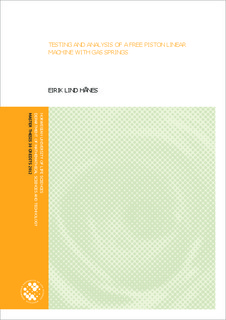| dc.description.abstract | This thesis is written in collaboration with Resonator AS, a company developing free piston linear machines for down-the-hole drilling applications. The free piston linear machine is designed to create heavy vibrations, which are used to break the rock. A successful product relies on the ability to deliver a sufficient hammering energy per blow to break the rock, at a high frequency, yielding a high rate of penetration (ROP). To reach the goal of making a faster drilling machine, Resonator has targeted electrical power density and stiff springs in the free piston linear machine, as critical factors. They have found mechanical springs inadequate for their application and are therefore researching the use of gas springs in a free piston linear machine. This thesis is focusing on the use of gas spring in a free piston linear machine. The use of gas springs in a free piston linear machine is analyzed and tested, important parameters for the performance of such a machine are investigated with emphasis on the gas springs. Critical design factors found are structural design, thermal design, surface specifications, seal configuration, lubrication and tolerances. These areas are investigated in detail for the tested prototype. Advantages and disadvantages for the use of gas springs in such a machine are discussed; the main advantage found is that high frequencies’ seem to be obtainable, the main disadvantage is the friction in the gas springs causing heat generation and decreased efficiency.
A linear spring equivalent for gas spring stiffness is derived to ease analysis of systems using high velocity gas springs. This linear spring equivalent has been used to predict the resonate frequency of the machine. Test results show good coherence between the predicted frequency and the measured. The gas spring stiffness equivalent has also been used to optimize the gas spring chamber size.
Based on the tests and analysis performed, improvements have been made to the prototype machine tested, and future improvements are suggested. The changes done to the original design yielded a substantial performance gain. Based on the analysis, it seems to be possible to further improve the machine performance by implementing the suggested improvements. Improvements are suggested in structural design, thermal design, surface texture, seal configuration, lubrication and tolerances. To confirm the results from the tests and analysis found in this thesis further testing needs to be performed. | no_NO |
